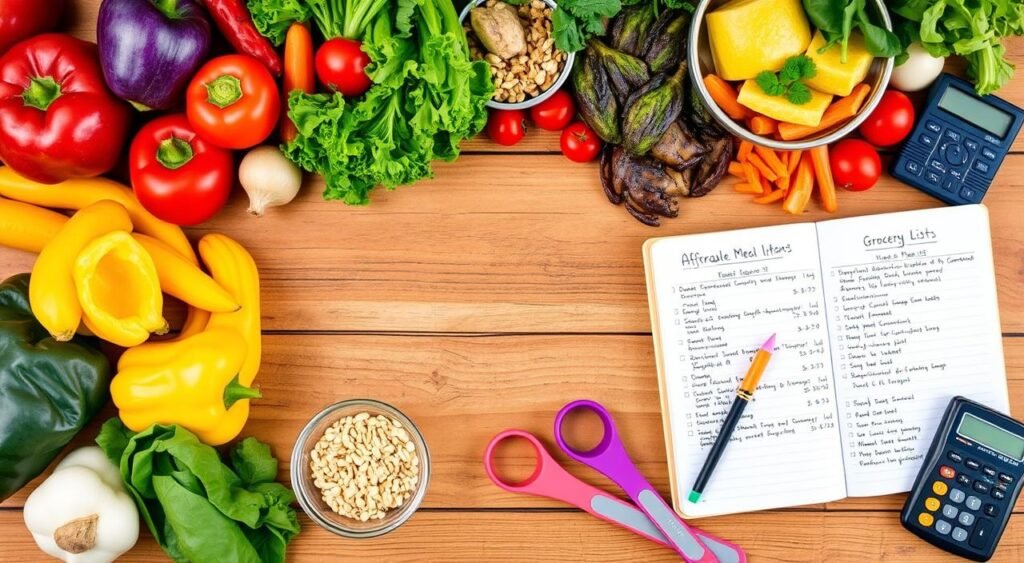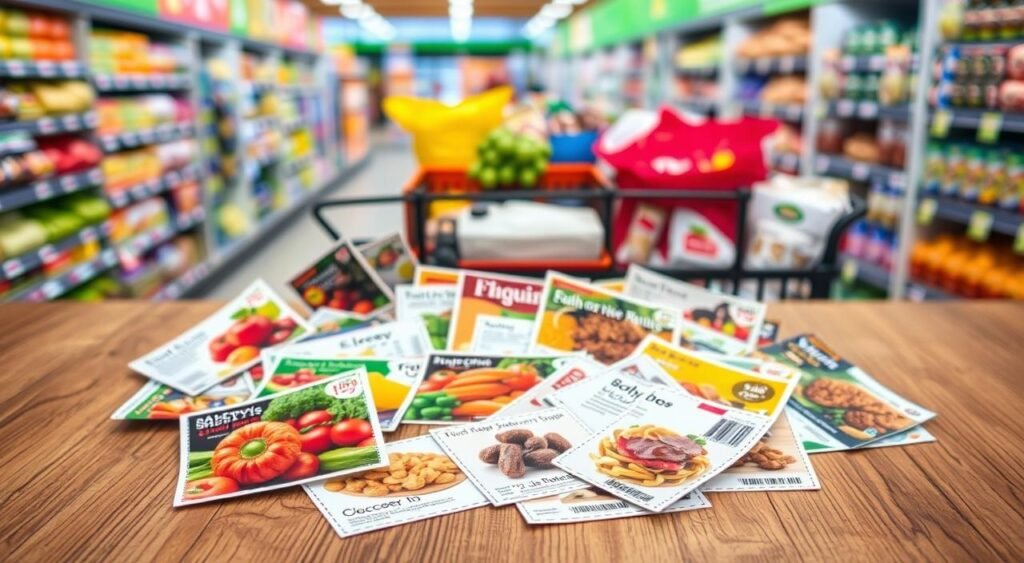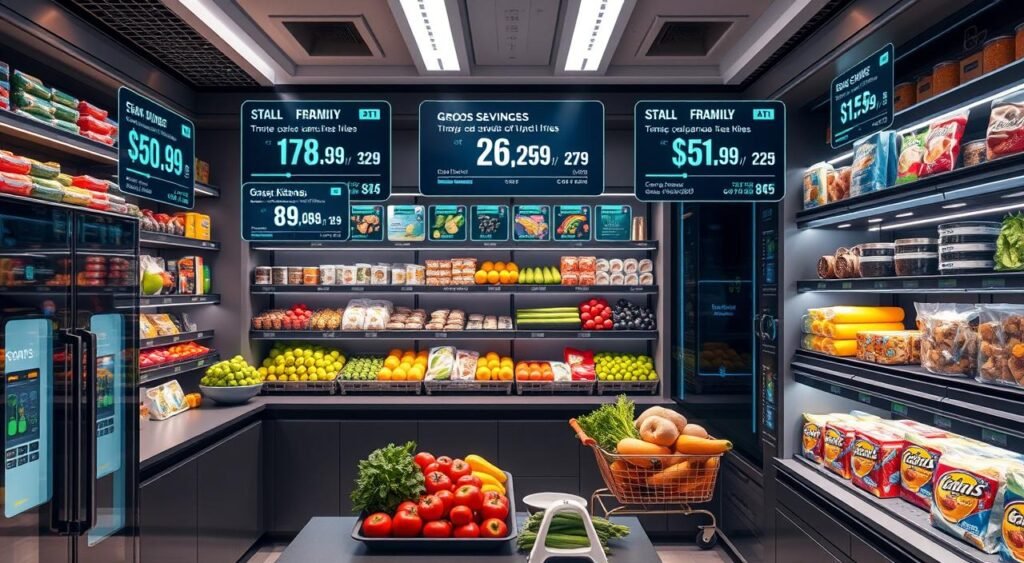Standing in the supermarket, I felt a shock at the prices. My weekly grocery bill had jumped up, making me feel stressed. Many families in America face the same issue with rising food costs. But I knew it was time to manage my grocery budget better.
The struggle is real. Grocery prices went up by nearly 12% at the end of 2022, as the U.S. Bureau of Labor Statistics reported. This big jump has made it tough for many families to afford food. But, there are smart ways to save money on groceries.
There are many ways to cut down on your grocery bill. For example, using rewards programs can earn you up to $350 a year. Making bread at home can give you 8 to 10 loaves for just $8, without any preservatives. We’ll look at more strategies to help you save on groceries.
Key Takeaways
- Grocery prices increased by almost 12% in late 2022
- Rewards programs can help customers earn up to $350 annually
- Using grocery lists prevents overspending on impulse buys
- Shopping post-holiday sales leads to significant discounts
- Homemade bread costs about $8 for 8-10 loaves
- Online grocery shopping with curbside pickup can help track spending
- The average monthly grocery cost for a family of four is about $975
Understanding the Impact of Rising Grocery Prices

Food prices have gone up a lot in recent years. This has made it harder for families to budget. Since 2019, food costs have risen by 4.8% each year, faster than the general inflation rate of 4.2%. Many families are now looking for ways to save money on groceries.
Recent Trends in Food Inflation
The Bureau of Labor Statistics found a 2.9% jump in food prices for 2023. Several things have caused this increase. These include problems in the supply chain, more demand, and how climate change affects food production.
For example, avian flu has cut down on egg supplies. This has made eggs and related products more expensive.
Impact on Household Budgets
Higher food costs really affect family budgets. Families with lower incomes spend a bigger part of their budget on food. This makes them more sensitive to price increases.
To deal with this, many are choosing store brands and making things at to save money.
Long-Term Effects of Price Increases
The long-term effects of higher food prices can be big. While the number of work hours needed to buy groceries has often gone down since 2015, recent increases have changed this. People are finding ways to adapt.
- They plan their meals to avoid buying things on impulse.
- They pick store-brand items over name brands.
- They shop at discount stores and farmers’ markets.
- They grow their own food when they can.
- They find creative ways to use up food to avoid waste.
By understanding these trends and using smart shopping habits, families can handle their grocery costs better, even with ongoing price increases.
Plan Before You Shop: The Foundation of Savings

Saving money on groceries starts before you go to the store. Affordable meal planning is crucial for cutting costs and reducing waste. By following a few simple steps, you can make cost-effective grocery lists and use cheap meal planning strategies.
Creating an Effective Meal Plan
Begin by planning your meals for the week. This can lead to big savings. Studies show that meal planning can save up to $347 in the first month. Using sales flyers for planning can save about $150 monthly, or $1,950 a year.
Inventorying Your Pantry and Fridge
Before planning meals, check what you already have. This stops you from buying things you don’t need and cuts down on waste. Meal planning helps you buy specific ingredients, which can prevent food from going bad.
Crafting a Detailed Grocery List
A detailed grocery list is key for saving money. Shoppers with lists can finish their shopping 30% faster, saving about 20 minutes. Shopping with a list also helps you avoid spending too much. Without a list, you might spend 20% more, which is an extra $30 weekly or $120 monthly.
“A well-planned grocery list is your roadmap to savings. It keeps you focused and helps avoid costly impulse purchases.”
By using these strategies, you’re setting a strong foundation for savings. Remember, good planning is the secret to affordable meal planning and making cost-effective grocery lists.
Smart Shopping Techniques to Save Money on Groceries
Learning how to use coupons for groceries can really cut down on what you spend. With prices going up 2.4% from last year, it’s key to shop smart. Here are some tips to help you save money.
One good trick is to use a calculator when you shop. This way, you can round up prices and stay within your budget. Paying with cash can also help you avoid spending too much. Don’t shop when you’re hungry and try to only go shopping when you really need to.
It’s also smart to compare prices per unit. Don’t always think that buying in bulk is cheaper. Sometimes, smaller sizes are a better deal. Look at prices on items that aren’t right in front of you, as they might be cheaper. Try different stores to find the best prices on what you need.
- Use grocery apps like Flipp to compare sales and prices
- Shop at farmer’s markets for fresh, affordable produce
- Consider international stores for unique, budget-friendly options
- Opt for curbside pickup to avoid in-store temptations
Smart couponing is more than just clipping coupons. It’s about making smart choices. Choose fruits and veggies that are in season, pick frozen veggies without added sauces, and go for canned fruits without sugar. These tips can save you a lot of money over time.
“Understanding unit prices can help shoppers identify better deals and determine the value for money when comparing products.”
By using these smart shopping tips, you can cut down your grocery bill a lot. The average family of four spends about $975 a month on food. With these strategies, you can save money and still eat well.
Leveraging Coupons and Sales for Maximum Savings

Smart grocery shopping means knowing how to use coupons and sales. This way, you can cut down your grocery bill and make your food budget go further.
Finding and Using Digital Coupons
Digital coupons have changed how we save on groceries. Stores now have apps or websites for digital coupons. Apps like Fetch or Ibotta give you rewards or rebates, adding more savings.
Utilizing Store Loyalty Programs
Joining store loyalty programs is key for smart shoppers. They offer special deals, coupons, and points for future buys. Some stores even have double coupon days for loyal customers, making your coupons worth more.
Timing Your Shopping with Sale Cycles
Knowing when things go on sale can save you a lot. For example, school supplies are cheaper in mid-summer. Produce is also cheaper when it’s in season. Pairing these sales with coupons can get you amazing deals.
“Starting with a small shopping list of 10 items on sale and pairing them with coupons can be a good way to begin couponing.”
Planning is the secret to saving on groceries. Look at store circulars, clip coupons, and make a list of the best deals. With time, you’ll get good at finding discounts and keeping your pantry full without breaking the bank.
Strategic Store Selection and Shopping Habits
Choosing the right store is crucial for saving money on groceries. Stores like Aldi, Market Basket, and Walmart have great deals. By comparing prices, you can save a lot on your shopping list.
When to shop is also important. Buying during off-peak hours or on special days can get you better prices. Many stores offer discounts for seniors, which is a big help for older shoppers.
Knowing when stores have sales can save you money. Shopping more often but buying less can also help. It reduces waste and helps you keep track of your spending.
Here are some interesting facts to keep in mind:
- 65% of shoppers make impulsive purchases when shopping on an empty stomach
- 44% of grocery items are found in the aisles, while 56% are on the perimeter
- 82% of consumers bring their own cooler bags for food safety
By choosing the right stores and shopping smart, you can cut down on your grocery bills. You won’t have to sacrifice quality or nutrition in the process.
Budget-Friendly Meal Planning and Preparation

Planning meals on a budget is crucial for saving money on groceries. With food prices going up, smart strategies help you stay within your budget. You don’t have to give up on taste or nutrition. Let’s look at some effective ways to shop and prepare meals affordably.
Incorporating Affordable Ingredients
The average American household spends almost 10% of their disposable income on food. To save money, focus on affordable staples. At Walmart, prices for items like garlic start at $0.44 and ground beef at $9.92 for 3 lbs.
Stock up on versatile items like eggs ($1.86 for 18) and milk ($5.22 for 2 gallons). These can be the base for many meals.
Batch Cooking and Freezer Meals
Batch cooking is a smart way to save money. Cook large amounts of meals and freeze them for later. This can cut your food budget to as low as $50 a week for a family of four.
Try making dishes like White Chili or Chicken Sheet Pan Dinner in bulk. This saves time and money.
Reducing Food Waste Through Creative Meal Planning
To reduce waste, plan meals around what you already have. Use apps or websites to find recipes based on your ingredients. Creative meal planning stretches your budget further. Home-cooked meals are about half the cost of eating out.
- Plan meals a week in advance to avoid impulse purchases
- Use store loyalty programs for additional savings
- Consider growing herbs or vegetables at home
By using these strategies, you can cut your grocery expenses while enjoying tasty, healthy meals. With careful planning and smart shopping, it’s possible to feed a family on a tight budget.
Maximizing Savings with Smart Product Choices
Choosing the right products is crucial for saving money at the grocery store. Making smart choices can help you spend less without losing quality. Here are some tips to help you save more on your grocery bill.
Comparing Unit Prices for Better Deals
One smart way to save is by comparing unit prices. This helps you find the best deals, especially on bulk items. Remember, bigger doesn’t always mean cheaper. Look at the price per unit to save 10-15% on staples.
Opting for Store Brands and Generic Products
Store brands and generics are often 20-30% cheaper than name brands. Yet, they’re just as good. Choosing generics can save you a lot without sacrificing taste or nutrition.
Buying Seasonal Produce for Freshness and Savings
Buying produce in season is both fresher and cheaper. Aligning your meals with seasonal produce can save you 15-20% over imported options. It also supports local farmers and cuts down on transportation costs.
“Shopping seasonal and local produce can result in savings of around 15-20% compared to buying imported produce.”
By using these tips, you can stretch your budget while still enjoying healthy, tasty meals. Small changes in your shopping habits can add up to big savings over time.
Using Technology and Tools to Enhance Savings

Shoppers are finding new ways to save money with AI tools. ShopRite’s Caper Carts give a $10 discount on a $53 bill. They also have a “spin the wheel” game for extra savings.
Kroger customers are saving big too. One person saved $29.49 with AI cart technology. These smart tools are changing how we shop and save.
Supermarket leaders are investing more in AI. They aim to use AI in almost all store equipment by 2025. This could save them $113 billion and bring in new revenue.
AI helps in more ways than just at checkout. Sam’s Club saw a 23% drop in exit times with AI for receipt checks. This makes shopping faster and better.
Here are some tech tips for saving:
- Use grocery store apps for digital coupons and deals
- Employ price comparison apps to find the best prices across stores
- Utilize meal planning apps to optimize ingredient use and reduce waste
Average Americans spend $438 a month on groceries. These tech tools could save a lot. By using supermarket technology, smart shoppers can cut their grocery bills a lot.
Conclusion
Trying to save money on groceries is more important than ever as food prices keep going up. Grocery costs have risen by 11% from 2021 to 2022. This makes it key to find ways to save money.
The average family of four spends about $975 a month on groceries. This shows how important it is to find affordable ways to shop.
Smart shopping can really help cut down on expenses. Buying groceries for curbside pickup can stop you from buying things you don’t need. Shopping for produce in season is also a good way to save money.
Using cash and limiting how often you go shopping helps keep your spending in check. Growing your own food and checking out ethnic markets can also save a lot of money.
Using loyalty programs, cashback credit cards, and wholesale stores are other ways to save. There are 30 strategies to help, from changing dinner plans to shopping when you’re not hungry. These tips can help families deal with higher food prices while still eating well.
FAQ
How can I save money on groceries by planning ahead?
To save on groceries, start by planning your meals and making a shopping list. This helps avoid buying things you don’t need. It also cuts down on food waste.
Check what you already have at home before you go shopping. This way, you won’t buy things you already have. Sticking to your list helps you spend less and avoid buying things on impulse.
What smart shopping techniques can help me save money?
Use a calculator to keep track of your spending while shopping. Rounding up prices can also help you save. Paying with cash helps you stick to your budget.
Try not to shop when you’re hungry. This can help you avoid buying too much. Shopping less often can also help you save money by reducing impulse buys.
Look at unit prices to find the best deals. Don’t just look at items on eye-level shelves, as they’re often more expensive. Try different stores to find the best prices. Curbside pickup can also help you avoid buying things you don’t need.
How can I maximize savings through coupons and sales?
To save more, use coupons and shop during sales. Buy the Sunday paper for coupons and follow your favorite brands on social media. Sign up for store loyalty programs to get discounts.
Keep an eye out for post-holiday sales to find great deals. But remember, only buy what you need, even if it’s on sale or you have a coupon.
What are some tips for strategic store selection and shopping habits?
Save money by choosing the right stores and shopping smart. Look for discount stores like Aldi and Walmart. Compare prices at different stores to find the best deals.
Shop during off-peak hours or on special days for better prices. Consider senior discounts and know when stores have sales to save even more.
How can budget-friendly meal planning and preparation help me save money?
Plan meals with affordable ingredients to save money. Use cheaper cuts of meat for slow-cooked dishes. Batch cooking and making freezer meals can save time and money.
Reduce food waste by planning meals creatively. Use AI to find recipes with ingredients you have. Making your own bread and growing your own herbs and vegetables can also save you money.
What are some smart product choices to maximize grocery savings?
Choose products wisely to save money. Compare unit prices to find the best deals. Opt for store brands and generic products for lower prices.
Buy seasonal produce for freshness and savings. Be aware of “shrinkflation” where package sizes decrease but prices stay the same, increasing the cost per unit.
How can technology and tools enhance my savings on groceries?
Technology can help you save on groceries. Use apps for digital coupons and deals. Apps for comparing prices and meal planning can also help you save.
Some people even use AI tools like ChatGPT to plan meals with ingredients they already have. This reduces waste and unnecessary purchases.









